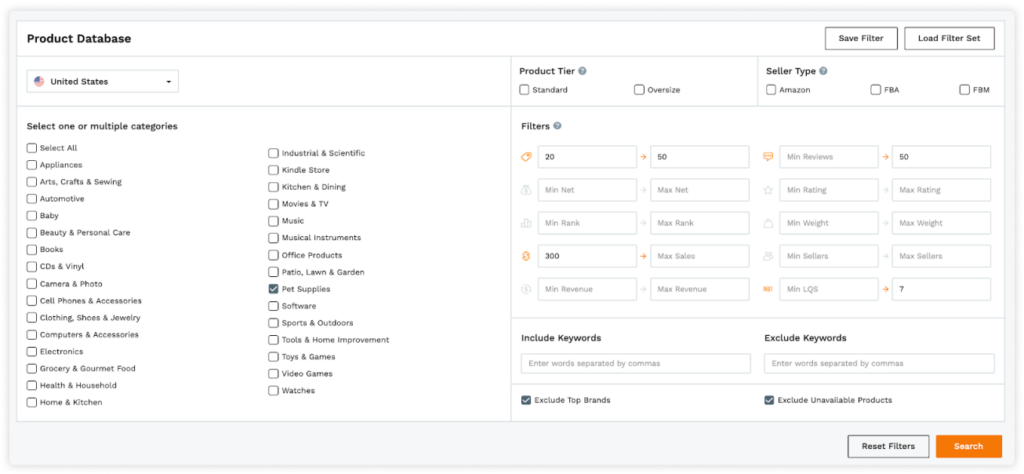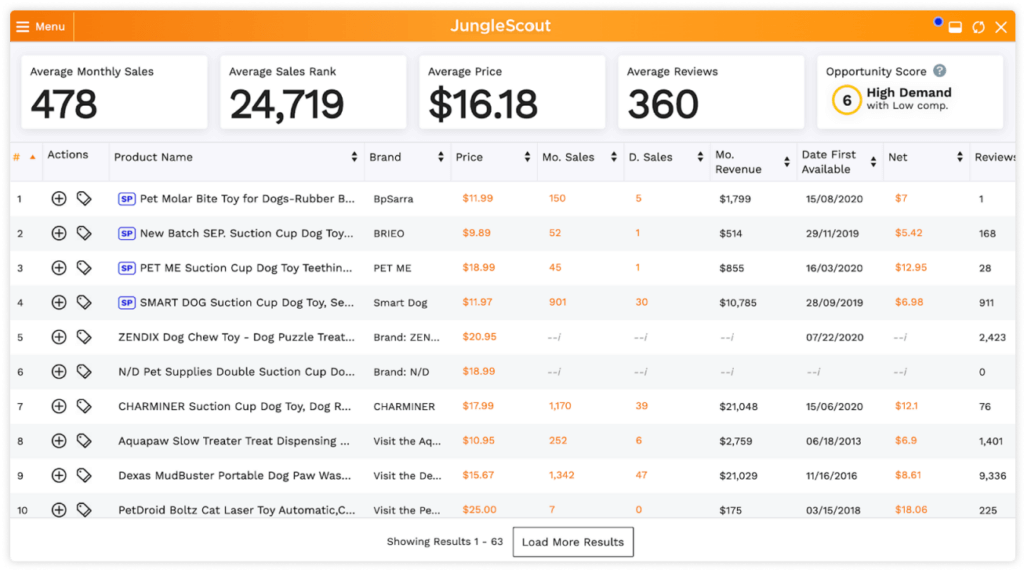Chapter 2
What to sell on Amazon
- Step-by-step product research
- Criteria for best-selling products
- Top Amazon product categories

What product should you sell on Amazon? How do you know if consumers will buy it? How do you know how to price it so you make a profit? We’ll cover all these questions and more, and we’ll show you exactly how to search for winning product ideas.
First, a few best practices that will help you enormously in your product research quest:
- Let data guide you, rather than picking a product to sell simply because it’s something you like. Trust us on this. (And if you do have an idea of what to sell, you can validate that with data on how similar products are performing on Amazon.)
- Don’t rush it. Product research is essential preparation that requires some time and analysis to be successful.
- Use a tool, like Jungle Scout, that can mine massive amounts of Amazon data to find a product with the trifecta of: high demand, low competition, and positive profitability. We’ll show you how.
How to find a profitable, high-demand, low-competition product to sell on Amazon
For all products you’re considering, analyze them for:
1.Profitability
For every product you’re evaluating, think: can I source and ship this to Amazon for substantially less than it’s selling for?
Generally, you can consider the “rule of 3’s” to estimate this. Each product’s sale is broken up into ⅓ for fees, ⅓ in landed costs, and ⅓ for you. (So, if the product sells for $15, you should expect to profit $5.)
Here’s a breakdown of how you can calculate potential profitability by assessing costs and revenue for each product opportunity.
Costs
Landed costs
The collective costs to produce and transport your product to Amazon’s warehouses:
Cost of inventory
Any preparation or inspection fees
Shipping
Duties
Amazon’s fees
Referral fee: Essentially Amazon’s “commission” for each item you sell on the platform, this is typically a flat 15% which you pay when a product sells
Selling plan fee: For professional Amazon sellers, a monthly fee of $39.99; for individual Amazon sellers (those who typically sell fewer than 40 units per month), a $0.99 per sales transaction (but no monthly fee)
Fulfillment fee: For FBA sellers, this per-product fee covers Amazon’s cost for packaging and shipping products, and it varies based on weight and dimensions of your product and which marketplace you’re selling in
Storage fees: FBA sellers pay either a monthly storage fee or long-term storage fees
Revenue
Of course your take of any sale will depend on how much you can buy the product for, and what fees come out along the way.
As a general rule, you want the product to sell for $20-$50 to allow for healthy profit margins. Below $20, profit margins are minimal and possibly not worth your effort. Above $50, some customers are often unwilling to spend higher amounts on a brand they don’t recognize.
Simply calculate your profits by subtracting fees and costs from your potential revenue.
“I recommend using Jungle Scout’s FBA Calculator to find out exactly what your profits and Amazon’s fees would be for a certain product. Simply plug in an ASIN that is similar in weight and dimensions to your product, the selling price, and your cost, and it will break down all of the selling fees and profit.”
2.Demand
The key component of a good product to sell on Amazon is demand. Do people want this product? Are they looking for it or is there a need or pain point this product could solve? We use data to answer these questions.
The key metric that helps us determine demand on Amazon is sales.
3.Competition
Next, we want to evaluate the competition, determining how many similar products exist and whether there is opportunity in the market for a newcomer.
The key metrics that help determine competition are the number of products and the number of quality reviews and ratings they have. In other words, are the products already listed on Amazon any good?
We’ll use Jungle Scout’s product research tools to explore these metrics and show you how to find profitable products to sell on Amazon.
In this clip, the jungle scout team tells you the main criteria for making data-driven product decisions.
What products sell on Amazon the most?
The top 10 product categories on Amazon are:
1.Home & Kitchen
2.Sports & Outdoors
3.Toys & Games
4.Health, Household & Baby Care
5.Beauty & Personal Care
6.Kitchen & Dining
7.Clothing, Shoes & Jewelry
8.Baby
9.Garden & Outdoor
10.Tools & Home Improvement
*These 10 categories are largest by quantity of FBA sellers. See more about Amazon product categories here.
Start your product research
We’ll show you how to create and narrow down a list of product ideas based on the main criteria above: profitability, demand, and competition.
Search Amazon’s product database
Using Jungle Scout’s Product Database, you can explore Amazon’s entire catalog (hundreds of millions of products), easily searching products based on specific filters to narrow down your product ideas.
Say you want to explore product opportunities in the Pet Supplies category. Select that category and then start adding your filters. (If you don’t know what category you want to dig into, explore several! Or, review our product category research and other methods of honing your product research in our guide.)
Filters (remember our main criteria above: profitability, high demand, and low competition):
- Price (for profitability): Aim for $20-50
- Sales (for demand): Aim for at least 300 units per month (~10 sales per day)
- Number of reviews (for competition): Of the top 10 listings of a particular product, we want 3-5 of them to have fewer than 50 reviews
- Rating: Find products with low star ratings, aiming for a maximum of 4 stars (these will give you the opportunity to improve products and beat the competition)
- Listing Quality Score, or LQS: Find products with listings that have room for improvements, aiming for a maximum of 5 to 7 LQS
These filters will narrow down your list of products with potential to explore further.

Here is an example of a good potential product that we can then dig deeper into:

Based on this information, you should continue to do more research into this niche.
Other factors you’ll want to evaluate should include:
- Size and weight of the product (for standard, affordable shipping)
- Ease of sourcing/manufacturing the product
- Seasonality (ideally, your products will be in demand year-round)
- Uniqueness (the market is not dominated by an existing brand)
(Most Amazon sellers are probably sticking to similar criteria when doing their product research. So, how can you outsmart your competitors? We go into each of these in greater detail in the Amazon selling guide.)
You can also do product research while browsing Amazon.com with Jungle Scout’s Extension. Simply click the extension and you’ll be able to view product data including Best Seller Rank, average price, average monthly sales, a custom Opportunity Score, and more on Chrome or Firefox browsers. You can also click to track products from here, which is a key step in evaluating a product’s potential.
See the following results from Jungle Scout’s Extension.

Track products over time to narrow your list
We recommend tracking as many listings as possible on the first page of the search results for a given product keyword for at least 2-4 weeks to monitor performance over time.
This isn’t necessarily to track for seasonality, which you can see more easily through search volume trends. Tracking your product for several weeks helps you be sure a product’s sales are not temporarily inflated due to promotions a seller may be running or other random factors.
Within Jungle Scout’s Product Tracker, you’ll see historical sales over time for all listings. You can change the view to the past 60 days, number of units sold per day, price, inventory levels, review count, and more details.
Find improvement potential
Your goal is to find a product opportunity with proven demand and profitability — but one in which you can compete. You’ll need to make your product better or different enough to appeal to buyers looking for unique features. There’s no need to reinvent the wheel, just differentiate yourself enough to stand out. (You’ll work with a supplier who will take care of all these changes for you — more on that below.)
Find improvement ideas by examining the reviews and the “Customer Questions & Answers” section of existing product listings. What do customers like or dislike about it? Consider all factors including color, material, size, usability, functionality, packaging, etc.
If you’re serious about a product, buy the competing products to learn first-hand about any potential pain points you could improve upon. Take notes (you can save notes in Product Tracker).
In this clip, Jungle Scout show you how to use Product Database and Extension to research profitable products.
Check for IP or other legal concerns
Selling products on Amazon means you’re creating a real business, and no doubt there are boxes to check and rules to follow, particularly when it comes to intellectual property (IP). Amazon cracks down on “black hat” behavior such as counterfeit products and trademark infringement, so make sure you find products that you have the right to produce and sell.
1. Patents
You cannot sell something that is patented because it means someone else owns the rights to the design, the way it functions, or another fundamental quality of it.
How do you know if there is a patent? Hiring a lawyer is one way to learn for certain whether a product has a patent, but here are some other steps you can take on your own:
- Google “patent” + [your product idea].
- Check listings on Amazon for that product and see if they mention anything regarding a patent.
- Check if there are many other people selling a similar product. If there are, it’s unlikely the product is patented because patent holders typically enforce their patents.
2. Trademarks
A trademark is any symbol, word, or group of words that a company legally registers or establishes use of to present their brand or product. You can’t put another company’s trademark on your product. For example, if you are selling a private label shoe, you cannot use the name “Nike” or Nike’s logo.
Before settling on a brand name, logo, or slogan for your Amazon business or a particular product, you should conduct a trademark check with the United States Patent and Trademark Office (USPTO).
3. Other restrictions and liabilities
Research whether Amazon has any restrictions or necessary certifications you need to have for a product or product category. For example, there are certain subcategories within Toys & Games in which you need a Children’s Product Certificate (CPC) to sell.
Simply go into Seller Central and create the product listing. As you select through to the subcategory level, Amazon will tell you if the product is restricted.
Also consider if someone could easily get hurt or sick using your product. Avoid products with greater chance of liabilities such as electronics, products for the body (cosmetics, lotions, and dietary supplements), and other obviously dangerous products (like those that are flammable or sharp).
Disclaimer: I AM not a lawyer, so be sure to seek legal counsel for any specific questions or concerns you may have.
Consider ease and practicality of sourcing
Especially for your first product, you want to find something that is going to be rather simple to produce and ship. Keep these variables in mind when narrowing down your product ideas:
1.Sourcing: Look for a product that will require simple changes — this means you’ll have fewer details to work out with a supplier and will have more supplier options to choose from.
2.Shipping: Smaller, lighter products are easier to ship, and you want sturdy material to survive the shipping process. You don’t want a product that is easily broken.
3.Importing: Unless you’re producing and selling a product in the same country (not very common for FBA sellers today), you’ll need to import products to the appropriate marketplace. Every country has certain regulations on what you can and can’t import. You can work with a freight forwarder (for free) for information regarding importing your products (more on this below).
“Your product idea doesn’t have to meet every criteria mentioned. As long as you let the data guide or validate a product idea, it’s important to keep your momentum. Don’t get stuck in analysis paralysis. Start getting samples of products and continue powering through the process!
So, how do you find someone to make your product?”
Chapter 2
Summary
We showed you how to find high-demand, low-competition opportunities and shared product research tips to help you find a profitable product to sell on Amazon.
We learned:
- Step-by-step product research
- Criteria for best selling products
- Top Amazon product categories
Tools mentioned:

Product Database

Product Tracker

FBA Calculator